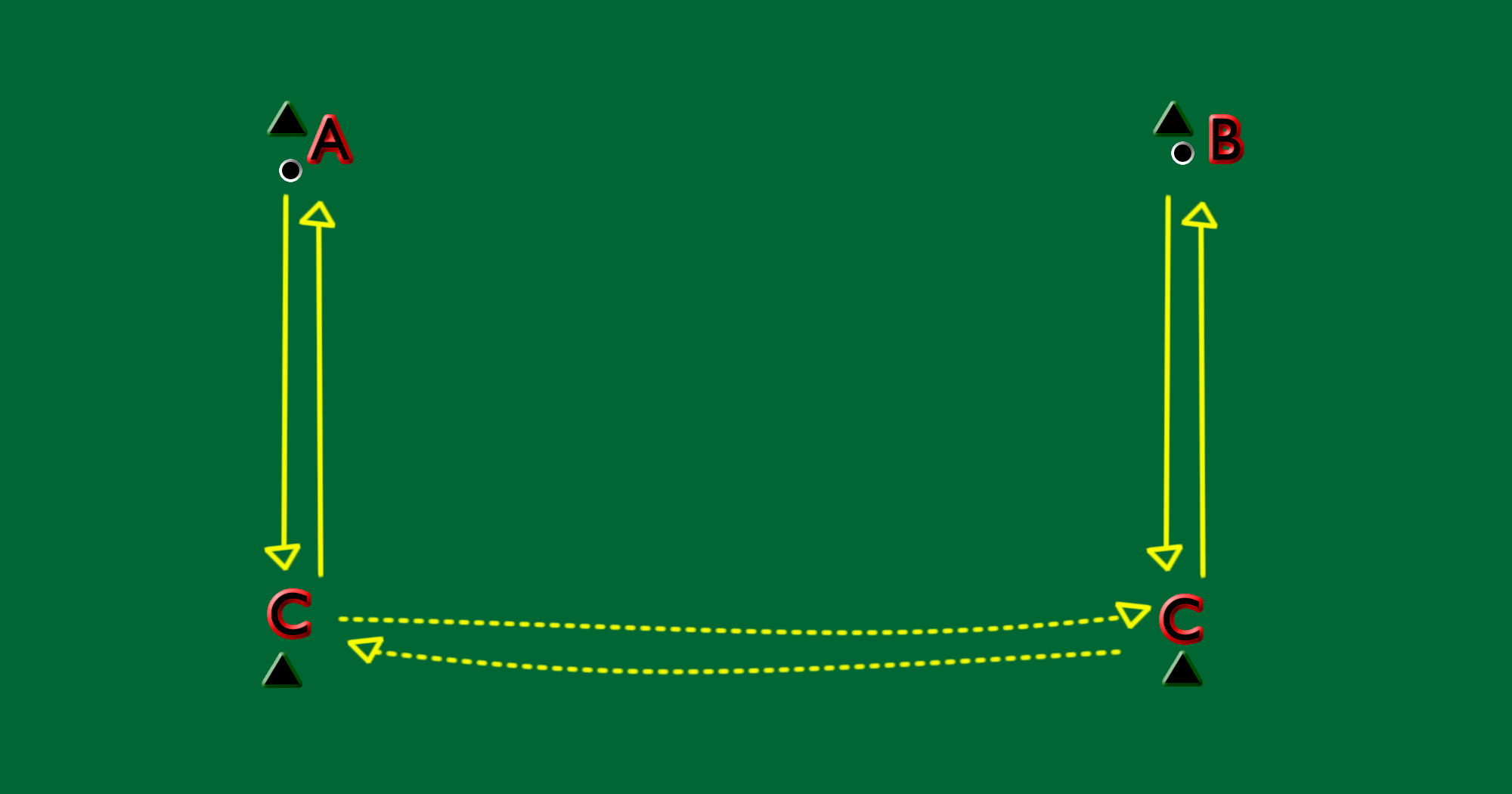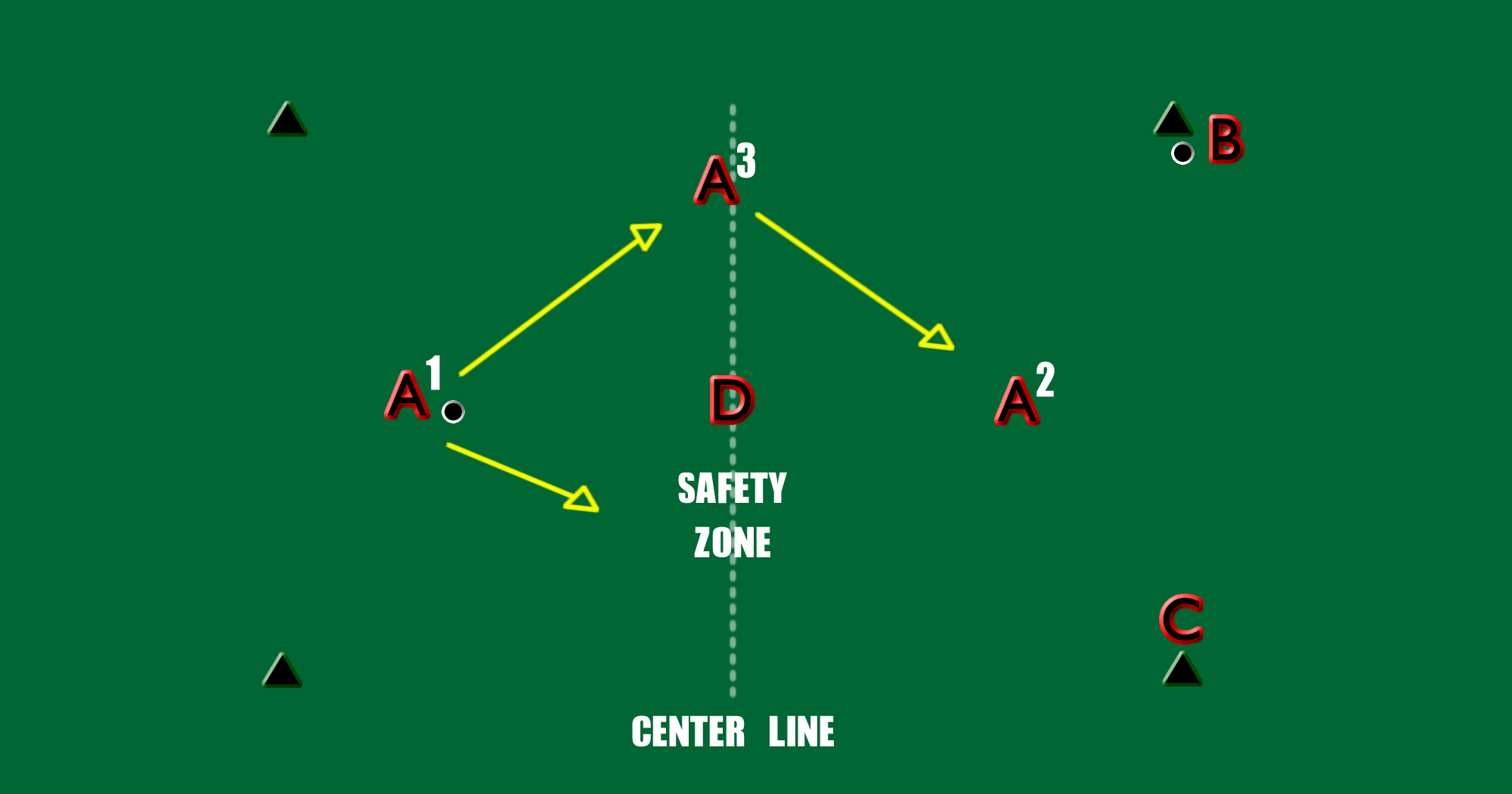FUNSTIX - Lesson 4
THEMES FMS: agility footwork, high knees, butt kicks, shuffle, hopping, jumping, basic stance
TECHNICAL: Push Pass Forward TACTICAL: Providing Passing Choices for the Player With the BallActivity 1 5 minutes Copy Cats; Players are assigned partners, each player with a hockey ball but no stick; The leader moves about the playing area while manipulating the ball, for example; between their legs, to the left and right; while lying on the ground; juggling it in the air; instructors should change the locomotor patterns frequently and also change the player roles frequently.
i) 5 minutes Sticks and Feet Place the players’ sticks on the ground in a line using various patterns ( for example; ladder, scattered, squares, zig zag, right angles.) players line up behind the sticks (no more than 6 players per line).One after the other players move through the pattern of sticks following the instructor’s directions while incorporating the following movements using small footwork and staying low.: small running steps; shuffle steps, skipping, jumping, hopping, high knees, butt kicks, At regular intervals, instructor calls out basic stance and all players assume the basic stance position. Each player should go through the sticks 3 times. HARDER incorporate arm actions with the footwork, move the sticks closer together, add a time element.
Activity 2
i) 6 minutes Keep Away Tag * Ratio of attacker to defenders should be at least 3:1 or 4:2
In a 20 yard square the possession team (A team) passes the ball around to avoid being tagged by the D team. A player can only be tagged if they are in possession of the ball. Instructors should encourage ‘A’ players to provide passing choices in front, behind and beside A1, and should make sure they stay away from the members of the D team. If a player is tagged while in possession of the ball, they change places with the ‘D’ player who tagged them. MAKE THIS ACTIVITY HARDER FOR THE A TEAM; make the space smaller, increase the number of defenders, specify the locomotor pattern MAKE THIS ACTIVITY HARDER FOR THE D TEAM: make the space bigger, increase the number of ‘A’ players, specify the locomotor pattern.
Activity 3
5 minutes Push Pass Forward Players should be positioned is a semi circle so they can all see and hear the instructor. Instructor demonstrates the correct technique for moving the ball forward using the push pass.
i) 6 minutes Wall Pass Each player practices the push pass while pushing the ball to a target (fence, goal, wall) MAKE THIS ACTIVITY HARDER: make the target smaller; move the passer further away from target; add a time element.
ii) 8 minutes Passing Through the Goal Instructor puts players into pairs of equal abilities. Partners stand 10 yards away from each other in the centre of 2 cones placed 5 yards apart. Each player tries to push the ball between their partner’s cones. The receiver uses correct technique to receive the ball and prevent it from passing through the cone and then uses correct technique to push the ball towards the other goal. MAKE THIS ACTIVITY HARDER; make the goal smaller, move the passer further away, count the number of successful ‘goals’ and receptions.

iii) 8 minutes Hot Seat * Players of equal ability are positioned is a triangle formation 10 yards apart. Players A and B each have a ball. A passes the ball to C who returns it to A and then C runs opposite B who passes a ball to C who returns the ball to B and then C runs to receive the ball again from A. After 10 passes, rotate players. Count which group can make the most passes in a specified time. MAKE THIS ACTIVITY HARDER FOR PLAYER C: add more distance between A and B; decrease the distance between A and C and B and C; MAKE THIS ACTIVITY EASIER FOR PLAYER C: decrease the distance between A and B; increase the distance between A and C and B and C; MAKE THIS ACTIVITY HARDER FOR A and B; after each pass they must run and touch a cone placed 10 yards behind them and return to receive the next pass.

Activity 4
i) 10 minutes Hockey Wall Blast l * Play with a playground ball or bean bags. In groups of 4; 1 player from the ‘A’ team is placed on either side of, and 5 yards behind, the centerline of a 20 yard square. The third player of the A team is positioned outside the sideline at the centre of the court. The D team player plays within the 10 yard area around the centre line. The player with the ball cannot move The objective of the A team is to score points by passing it back and forth to each other without the D team player touching the ball. The A team players can use their sideline player to help by pass the D player or they can pass the ball directly across the centre line if there is a passing lane. The attackers score one point for each time an A player on the court receives the ball. The D player scores a point every time they touch the ball. Play until one team makes 10 points and the rotate positions. MAKE THIS ACTIVITY HARDER FOR D; make the playing space wider; add another A player on the other sideline; allow the player with the ball to move 3 steps; MAKE THIS ACTIVITY HARDER FOR A; narrower space, increase the size of the safety zone; play with hockey sticks and a hockey ball.

LESSON 4 CONTENT LEARNING DESCRIPTORS
FUNDAMENTAL MOVEMENT SKILLS
HIGH KNEES: Players run on the balls of their feet flexing their hips and bending their knees so that their knees come to hip level. This dynamic stretching activity can be made more difficult with upper twisting. It is also helpful to have the players hold their sticks in front of them, with extended arms, at waist level, and attempt to contact the stick with their knees.
BUTT KICKS; with the weight on the balls of their feet and leaning slightly forward, players bend their knees and try to contact their backsides with their feet. Players’ arms should be bent at the elbows and move alternately with the legs.
HOPPING: keep the leg that is off of the ground bent, lean forward, move arms forward, stay on balls of feet, toes, use arms for balance, land lightly, reach for sky when you hop.
JUMPING: bend knees and elbows before take off, move arms high and back before jumping, swing arms forward and up as fast as possible when leaving the ground, hold arms high while in the air, bend knees after take off, land on the balls of the feet, bend knees and keep body weight forward when landing.
SKIPPING: a series of step hops done with alternate feet. Teach skipping by having learners step and then hop on the same foot and then step and hop on the other foot swing arms to shoulder height in opposition with the feet, skip on the balls of the feet, keep movements smooth, speed and distance are not important, transfer weight from one foot to the other while doing the hop, step-hop, swing arms smoothly.
SHUFFLE: the feet move in the following sequence-right, left, right; left, right left, the weight is on the balls of the feet with the knees slightly bent; the feet move quickly with short steps and the back foot never passes the front foot; the feet stay close to the ground.
BASIC STANCE (READY POSITION): feet shoulder width apart, keep feet below your shoulders; left foot slightly ahead of the right; weight low (sit); head Stick head rests on the ground in front and slightly to the right of the body. Player should be looking forward with head up for maximum vision and not down at their feet.
CATCHING : (to make catching easier, increase the size of the ball)
Arms relaxed at the sides with forearms in front of the body; players should reach for the ball, place their hands on the sides of the ball, bend their arms and bring the ball towards their body, watching the ball right into their hands. Encourage players to take a step back and bring their elbows towards their chest to help absorb the force of the ball.
OVERHAND THROWING (to make throwing easier, decrease the size of the ball)
The non - throwing side faces the target; swing the throwing arm out to the side and backwards bringing the arm with the ball behind the ear; keeping the elbow out, twist the body towards the arm that is holding the ball, keep the other arm raised for balance; extend the throwing arm forward and point the thumb towards the ground while stepping forward with the weight on the foot that is closer to the target; twist the body toward that leg as the ball is released
TECHNICAL: Push Pass Forward. The purpose is to move or pass the ball with accuracy and power over a short distance to a teammate. Standard Grip; Left hand is at top of the stick and right hand remains midway on the shaft of the stick. Ball and stick are positioned on the right side of the right foot, beside the body. Feet are staggered, with left foot ahead of the right foot, knees are slightly bent; head is down watching the ball on the stick. Flat side of stick is directly behind the ball to the side of the right foot.
Action: There is no backswing of stick (and no sound) to start movement and stick remains in contact with ball while being “pushed” towards target. The weight is shifted from the right foot to the left foot as the ball is released from the head of the stick towards the target. The left hand leads the push with the right hand supplying the force and following through towards the intended target.
TACTICAL: Providing Passing Choices for the Player With the BallPlayers on the possession team who do not have the ball need to provide passing choices ahead of, on either side of the ball, and behind the player with the ball. Instructors need to focus on teaching the movements and decisions of off ball attackers…where to move and when to move….continually reinforcing the 4 choices of direction
- Learning to Train (1.83 MB)
- Fundamentals (1.42 MB)
- Fundamentals (1.53 MB)
- Fundamentals (1.63 MB)
Filtering
Instructions for Filtering the Resource Centre.
Click on a specific tag in the filter list to view articles and resources related to that tag.
For example, click on Attacking to filter the resource centre for attacking.
You can also do keyword based searching.

